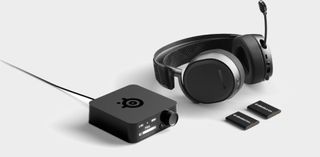An experimental AI wearable recognises objects and tells visually-impaired users details of what they're holding
AI image recognition and bone-conduction technology unites in the name of accessibility.

While technology has often sought to improve the lives of people living with disabilities, creative AI implementations may be the next logical step. The National University of Singapore has been demonstrating its experimental new wearable, and thanks to an AI helping hand and some creative use of existing technologies, it hopes to transform the experience of daily life with a visual impairment.
Called the AiSee, the wearable device is worn around the back of the neck like a regular set of headphones you might use for fitness, but hidden in the forward-facing section of the chassis is a 13-megapixel camera (via New Atlas). When the user picks up an item they can take a photo of it using a button on the side of the device, before that image is then processed using the onboard microprocessor and beamed to a cloud network using the internal wireless connection, which then uses AI algorithms to analyse the size, shape, colour and any visible text.
If the object is recognised the user is then told what the object is with a brief description, using a computer-generated voice relayed back through the bone-conduction headphones. This also allows anyone wearing the device to hear the world around them, a feature of vital importance to someone relying heavily on their sense of hearing to navigate.
Should the user need more information on the scanned object, they can then ask the AI verbally for more description or help.
The device itself has been designed to be discreet and is unlikely to draw any more attention than someone wearing a regular set of linked headphones. It also makes use of an internal lithium battery pack and doesn't require a link to a smartphone or any other device to work.

Best wireless gaming mouse: ideal cable-free rodents
Best wireless gaming keyboard: no wires, no worries
Best wireless gaming headset: top untethered audio
The AiSee is still currently a work in progress, and the researchers say they are now working on enhancements to make the technology more accessible and affordable, including speeding up the image recognition time and improving the visual recognition elements.
While it might be tempting to throw our collective hands up at some AI powered devices and critique their potential utility, in terms of making the world a more accessible place for those with disabilities there are some real and important use cases where AI can potentially do some real good.
The biggest gaming news, reviews and hardware deals
Keep up to date with the most important stories and the best deals, as picked by the PC Gamer team.
Similarly, wearable devices like the Apple Vision Pro may be drawing some ire, but the utility of similar wearable technology adapted for the differently-abled may well prove to be the key to unlocking a much more accessible world for everyone.

Andy built his first gaming PC at the tender age of 12, when IDE cables were a thing and high resolution wasn't. After spending over 15 years in the production industry overseeing a variety of live and recorded projects, he started writing his own PC hardware blog in the hope that people might send him things. And they did! Now working as a hardware writer for PC Gamer, Andy's been jumping around the world attending product launches and trade shows, all the while reviewing every bit of PC hardware he can get his hands on. You name it, if it's interesting hardware he'll write words about it, with opinions and everything.

After closing its AAA games development studio, Netflix Games VP transforms into the VP of GenAI for Games and the gobbledygook must flow: 'a creator-first vision… with AI being a catalyst and an accelerant'

OpenAI has bought the URL of what used to be an adult video chat website for more than $15,500,000
Most Popular






